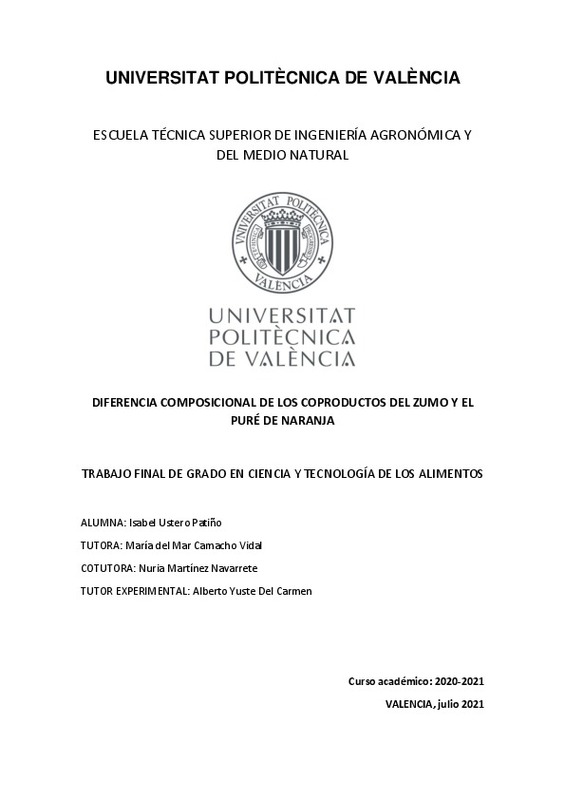|
Resumen:
|
[ES] Como resultado de las diferentes actividades de la industria agroalimentaria, se genera una gran cantidad de residuos orgánicos que deben ser gestionados de manera adecuada ya que impactan negativamente sobre el medio ...[+]
[ES] Como resultado de las diferentes actividades de la industria agroalimentaria, se genera una gran cantidad de residuos orgánicos que deben ser gestionados de manera adecuada ya que impactan negativamente sobre el medio ambiente. Cada vez más, se busca una revaloración de estos desechos para encontrar los beneficios que pueden aportar a los seres vivos. Con relación a la producción de naranjas, algunas industrias de transformación reutilizan los residuos provenientes de esta fruta obteniendo productos destinados al consumo animal, sin plantear la posibilidad de extraer compuestos bioactivos o utilizarlos de manera que se puedan emplear como ingredientes funcionales en alimentación humana saludable. Para poder encontrar su mejor uso, y con la intención de aplicarlo en forma de polvo por la mayor facilidad de manejo y mayor vida útil, se ha buscado tenerlo, previamente, debidamente caracterizado. La composición de estos coproductos, compuestos principalmente por piel, en el caso de la industria de las conservas, y piel, segmentos y zumo, en el caso de la industria de extracción de zumo, es similar pero no igual y por eso se ha realizado una comparación entre ambos, ya que la diferente composición podría dar lugar a productos en polvo con diferentes propiedades y, por tanto, con distintos usos. En este sentido, en este trabajo se ha realizado un análisis proximal de los coproductos del zumo y del puré de naranja determinando la humedad, azúcares totales, proteínas, cenizas, grasas y fibra dietética total, soluble e insoluble. Además, se ha analizado el contenido en vitamina C, hesperidina y narirutina, viendo también cómo afecta la adición de goma arábiga (GA) y almidón esterificado con ácido octenil succínico (OSA) a su estabilidad. Los resultados han mostrado que ambos coproductos son similares en macrocomponentes pero el proveniente del zumo es más rico en compuestos bioactivos. Los biopolímeros añadidos no parecen ejercer un claro efecto protector sobre estos compuestos.
[-]
[EN] As a result of the different activities of the agri-food industry, a large amount of organic waste is generated, which must be properly managed as it has a negative impact on the environment. Increasingly, a re-evaluation ...[+]
[EN] As a result of the different activities of the agri-food industry, a large amount of organic waste is generated, which must be properly managed as it has a negative impact on the environment. Increasingly, a re-evaluation of this waste is being sought in order to find the benefits it can bring to living beings. In relation to the production of oranges, some processing industries reuse the waste from this fruit to obtain products for animal consumption, without considering the possibility of extracting bioactive compounds or using them as functional ingredients in healthy human food. In order to find the best use for them, and with the intention of applying them in powder form because they are easier to handle and have a longer useful life, we have sought to have them duly characterised beforehand. The composition of these co-products, composed mainly of peel, in the case of the canning industry, and peel, segments and juice, in the case of the juice extraction industry, is similar but not the same, which is why a comparison has been made between the two, as the different composition could give rise to powdered products with different properties and therefore different uses. In this sense, in this work, a proximal analysis of the two co-products has been carried out, determining the moisture, total sugars, proteins, ashes, fats and soluble and insoluble dietary fibre. In addition, the content of vitamin C, hesperidin and narirutin to see how the adiction of gum arabic (GA) and esterified starch with octenyl succinic acid (OSA) affect its stability. The results have shown that both co-products are similar in macrocomponents but the one from the juice is richer in bioactive compounds. The added biopolymers do not appear to exert a clear protective effect on these compounds.
[-]
|







